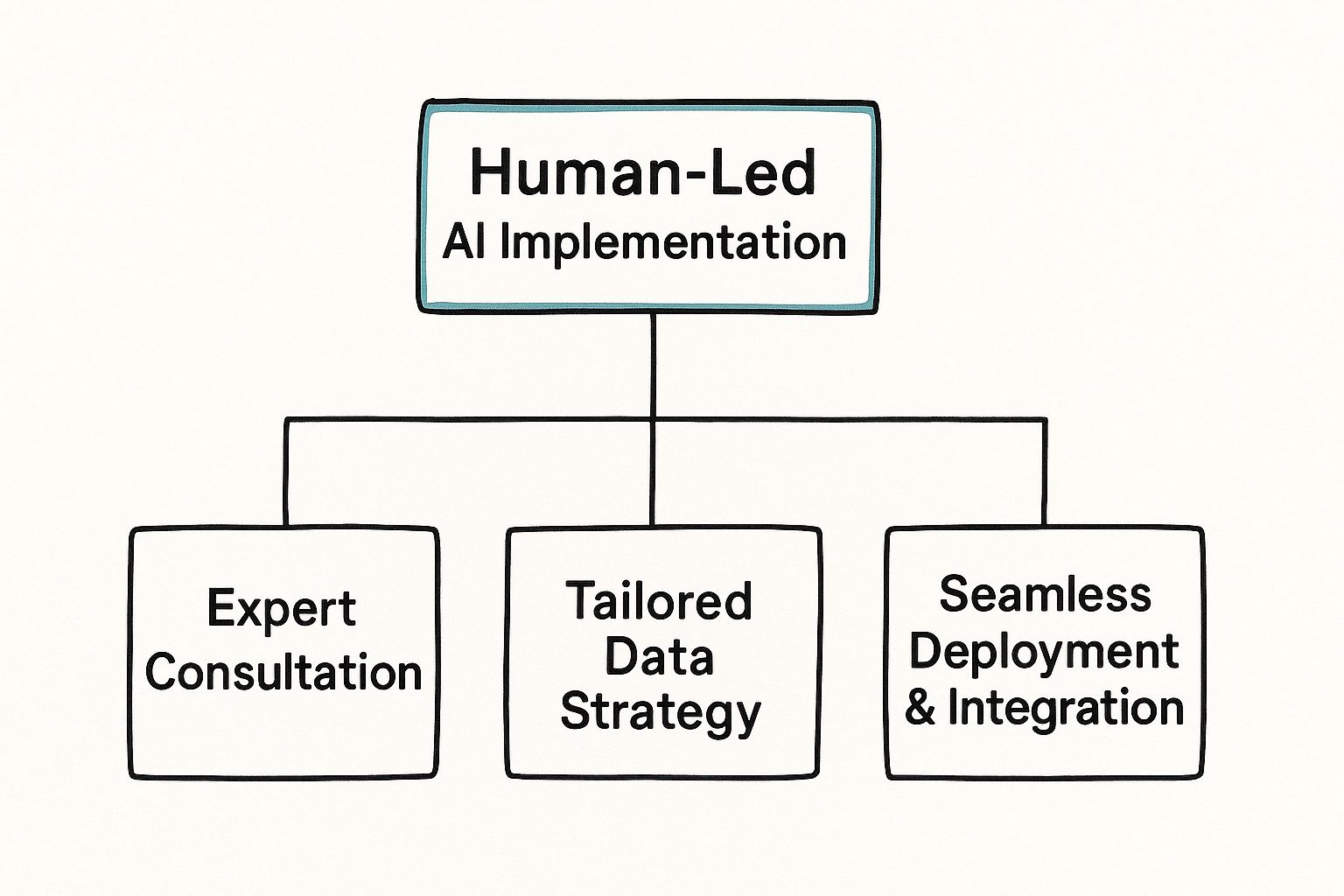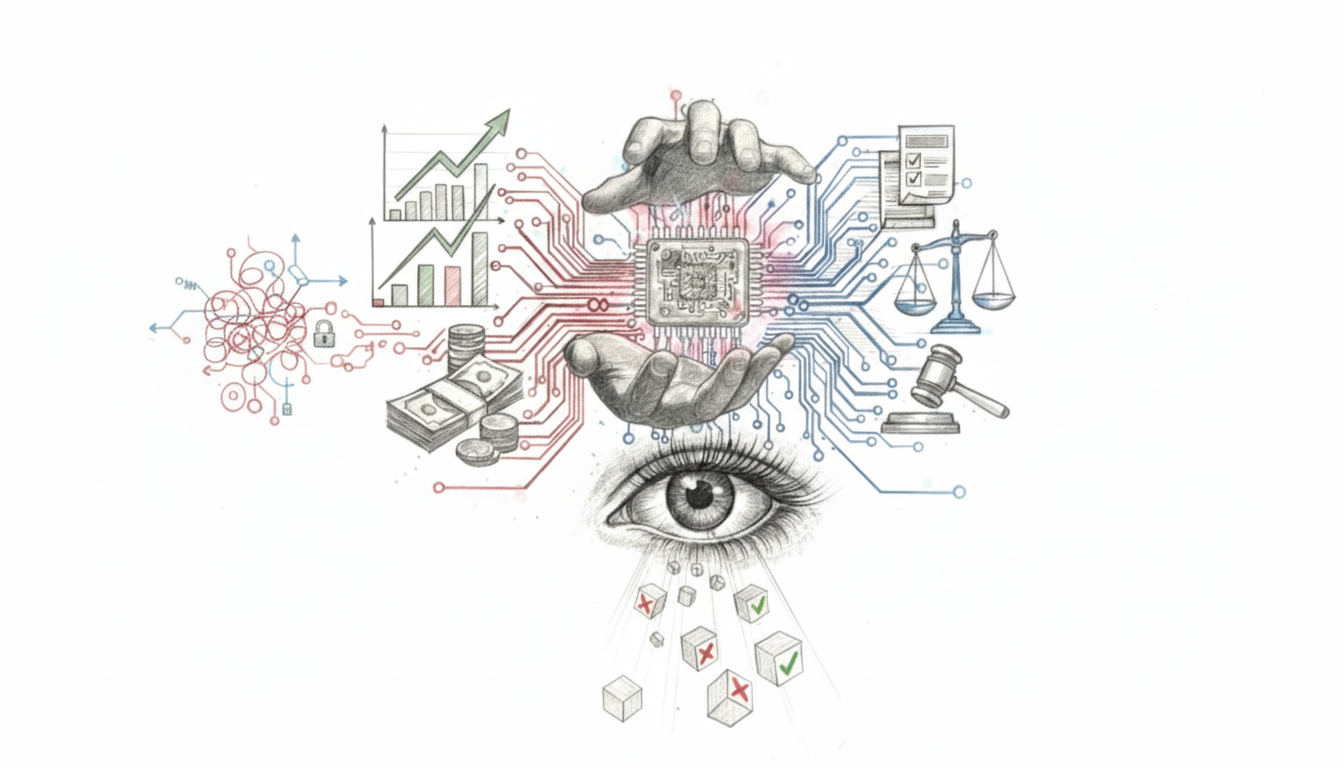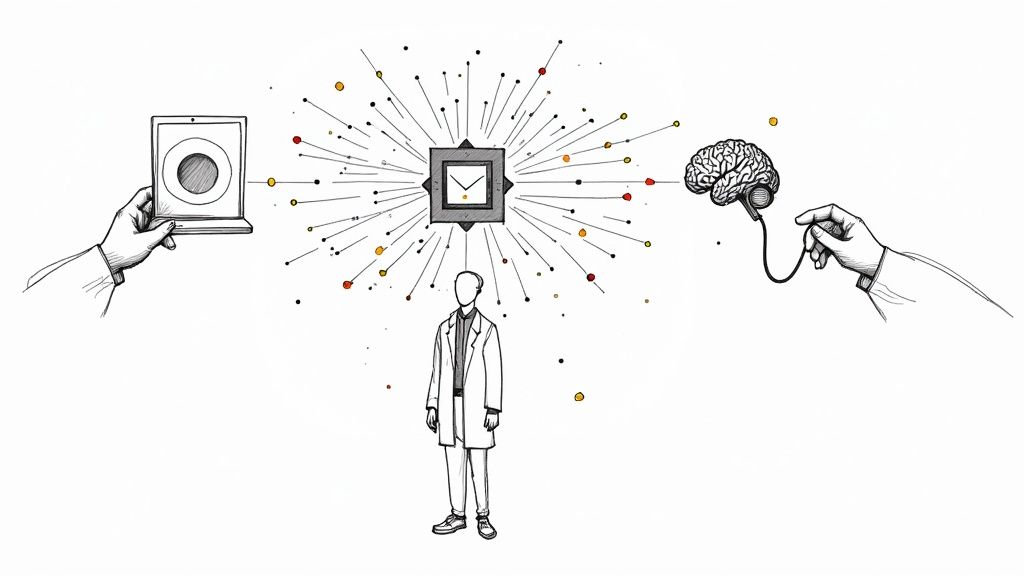Human-Led AI Consulting for Digital Transformation Guide
Explore how human-led AI consulting for digital transformation drives growth. This guide offers expert strategies for successful, human-centric AI integration.

Genuine digital transformation isn't about just plugging in the latest AI tools and hoping for the best. It’s about thoughtfully weaving that technology into the very fabric of your business, guided by human wisdom. Human-led AI consulting for digital transformation acts as your strategic partner in this process, making sure powerful tech serves your core business goals—not the other way around. It's the essential bridge between complex algorithms and tangible, real-world results.
Why Human Insight Is Crucial for AI Transformation
Think of artificial intelligence as a brand-new, top-of-the-line aircraft. Its autopilot is incredibly sophisticated, but you wouldn't send it on a cross-country flight without a seasoned pilot at the controls. That pilot is there to navigate unexpected turbulence, make critical judgement calls, and ensure the plane and its passengers arrive safely and on schedule. Human-led AI consulting provides that same essential piloting for your organisation's journey.
This approach is about more than just installing software. It gets to the heart of how AI can fundamentally improve your processes, empower your teams, and create growth that lasts. We're seeing a clear shift in the industry away from just experimenting with AI. In fact, nearly half (49%) of technology leaders now say AI is fully baked into their core business strategy.
The Pilot in the Cockpit Philosophy

The "pilot in the cockpit" idea is central to getting AI integration right. It's not about distrusting the technology; it’s about enhancing it with skills that are uniquely human. An AI can crunch data at a mind-boggling speed, but it doesn't have the nuanced, contextual understanding or ethical compass of an experienced person.
A human-led model makes sure that AI serves people, not the other way around. This is especially vital in any customer-facing role. For example, an AI assistant can help a service agent pull up a customer's history in seconds, but it’s the agent who provides the empathy and creative problem-solving that builds trust and keeps customers coming back.
A human-led approach prioritises using AI to create tools and systems that help employees do their jobs more easily and efficiently. It’s about reducing friction, not replacing critical human interaction.
This method also tackles one of the biggest hurdles in AI adoption head-on: managing risk. Without expert oversight, AI models can drift, producing biased or even harmful outcomes. Human consultants build the necessary guardrails and safeguards right from the start, ensuring your AI initiatives are both responsible and effective. This proactive governance, championed by senior leadership, is what gives businesses the confidence to innovate quickly while keeping regulatory and reputational risks in check.
Defining the Human-Led AI Consulting Model
So, what does human-led AI consulting for digital transformation actually look like on the ground? Think of it less like buying a piece of software and more like forming a strategic partnership. You have seasoned human experts who are there to guide every single step of your company's journey into AI.
This is a world away from the common "technology-first" mindset. That approach often falls flat because it fixates on the shiny new tools and completely overlooks the people, processes, and unique business context that make an organisation tick.
In a human-led model, the consultant acts as a vital translator. They're the ones who bridge the often vast gap between the technical jargon of artificial intelligence and the real-world, tangible results you need to see in your business. It means they start by asking about your specific challenges and goals, not by pushing a particular technology.
Imagine a manufacturing firm. A human-led consultant wouldn't just install a predictive AI to tell them when a machine part is about to fail. They'd go deeper, helping the company use that insight to completely redesign its supply chain, guide the retraining of its workforce for a new data-centric reality, and build a culture that embraces constant improvement.
The Core of the Human-Led Approach
At its heart, this consulting style is built on two things: collaboration and context. It’s rooted in the simple truth that AI, for all its power, is just a tool. It needs a human hand on the tiller to steer it towards creating genuine value.
This process typically involves:
Pinpointing the Right Problems: The consultant works shoulder-to-shoulder with your teams to find the high-impact areas where AI can solve a real, nagging business pain point—not just a theoretical one.
Ensuring Ethical Deployment: They help establish clear frameworks to manage potential bias and maintain transparency. This is absolutely critical for building and keeping the trust of your customers and employees.
Managing Cultural Shifts: A successful AI project is about so much more than new software. It demands a change in mindset across the organisation, and human experts are there to help navigate that transition smoothly.
This kind of strategic guidance is becoming more important by the day. In Europe, the AI market is projected to skyrocket from USD 87.84 billion in 2024 to an estimated USD 1,433.67 billion by 2033. This growth is fuelled by the demand for this exact blend of human expertise and powerful technology. You can delve into the specifics by checking out the research on the European AI market outlook.
This surge in demand makes one thing clear: businesses are realising that navigating complex regulations and building lasting trust requires something more than an algorithm. It requires human oversight.
Visualising the Transformation
Digital transformation isn't a single project; it's a complex process that weaves technology into every fabric of a business. The diagram below shows just how interconnected all the different domains are on this journey.

As this visual makes clear, technology is just one piece of a much bigger puzzle. A human-led approach ensures every technological decision is made in lockstep with your main business strategy and your commitment to the customer experience. This creates a powerful, cohesive, and truly effective transformation.
The Core Pillars of a Human-Centric AI Strategy
A solid, human-led AI strategy doesn't just happen. It's built on purpose, with clear, foundational pillars that guarantee technology serves the business, not the other way around. This approach to human-led AI consulting for digital transformation is about creating real, lasting change, not just ticking off another tech project.
At its heart, this is a balancing act—pairing powerful AI with essential human wisdom. For any digital transformation to stick, every single initiative needs to be grounded in four key areas.
Strategic Business Alignment
The first pillar is simple but crucial: every AI project must solve a real business problem. It’s incredibly easy to get dazzled by the latest and greatest tech, but the only question that matters is, "How does this help us?" This means no more tech for tech's sake. Instead, the focus shifts to measurable results, like making operations more efficient, keeping customers happier, or opening up new ways to make money.
A human-led consultant's first job is to get under the hood of your business—to understand your daily challenges and your biggest goals. This ensures the AI solution they help you build isn't just technically clever, but that it actually fits your vision and makes commercial sense.
Ethical and Responsible AI
Building fairness, transparency, and accountability into your AI from the very beginning isn't optional; it's a must. This pillar directly tackles the very real risks of algorithmic bias, which can do serious damage to your brand and land you in hot water with regulators, especially in places with strict rules like the EU.
This is where human oversight becomes your most important safety net. You need experts to check the data going in, question the results coming out, and set up clear rules for how AI is governed. To build trust with your customers and your own team, you have to show you're committed to doing AI the right way. You can learn more about creating a solid foundation by exploring our guide on developing an effective AI strategy.
The image below gives a clearer picture of how expert guidance helps put these principles into action.

As you can see, expert consultation is the starting point for crafting a bespoke data strategy and ensuring everything integrates smoothly.
People-First Change Management
Technology is only as good as the people who use it. This pillar is all about getting your teams and your entire company culture ready for the changes AI will bring. It means being open and honest, providing the right training, and designing new ways of working that empower your employees instead of making them feel obsolete.
Let's be honest: managing the human side of change is often the hardest part. But it's also where you'll find the most value.
A human-centric approach is built on collaboration. It ensures that new AI tools are adopted enthusiastically because they are designed to help people succeed, reducing friction and freeing them up for higher-value work.
Continuous Value Creation
Finally, a human-led strategy treats AI as a living, breathing part of the business—not a one-and-done project. The goal is to create a constant feedback loop, where insights from AI are always being used to sharpen processes and spot the next big opportunity.
This approach makes sure your investment pays dividends long after the initial rollout. This growing need for sustained, expert guidance is reflected in market trends. The AI consulting services market in Europe is projected to surge from USD 11.07 billion in 2025 to USD 90.99 billion by 2035. That's a massive jump, and it shows that businesses realise they need ongoing human expertise to manage and scale their AI systems effectively.
Of course. Here is the rewritten section, crafted to sound completely human-written and natural, while adhering to all your specific requirements.
Human-Led AI Consulting in German Industries
To see what a human-led approach to AI looks like in the real world, you only need to look at Germany. As Europe’s economic heavyweight, its famed manufacturing and automotive sectors are navigating a monumental shift. Think of the country-wide Industrie 4.0 initiative or the global race to electric vehicles (EVs). In this high-stakes environment, human-led AI consulting for digital transformation isn’t just a nice idea—it’s a boots-on-the-ground necessity.
Let’s get specific. Picture a medium-sized German automotive supplier, one of the classic Mittelstand companies that form the backbone of the economy. They’re pivoting from making parts for combustion engines to producing complex EV components. The mountain they have to climb is enormous. It means retooling entire production lines, hitting unforgiving new quality standards, and, crucially, getting their workforce ready for a completely new way of working.
A purely technology-driven approach would just drop in some new AI-powered quality control cameras and predictive maintenance software and call it a day. But that’s a recipe for failure because it completely misses the human side of the equation. The real gains are found when people work together.
A Practical Case Study in Action
Now, imagine a human-led consulting team walking onto that factory floor. Their job isn’t just to install software. It starts with a conversation. They work side-by-side with the German engineers, the ones who have spent decades perfecting their craft. Together, they map out the existing workflows and pinpoint exactly where AI can make the biggest difference—not by replacing that deep engineering knowledge, but by augmenting it.
This kind of partnership leads to a few key breakthroughs:
Refined Production Lines: You don’t get a one-size-fits-all AI solution. Instead, the system is fine-tuned to the exact tolerances needed for high-performance EV batteries, something only the on-site experts would truly understand.
Targeted Workforce Retraining: The consultants build and deliver training that gives employees the skills to work with the new AI systems, turning fear and uncertainty into confidence and buy-in.
Guaranteed Regulatory Compliance: They ensure the new AI-driven processes meet—and often exceed—the strict European and German quality and safety standards. In the automotive world, this is absolutely non-negotiable.
This is the essence of why human-led consulting works so well in Germany. It’s about bridging the gap between technological potential and tangible business results, with human expertise guiding every single step.
The Economic Significance for Germany
The sheer scale of this change is staggering. As Europe's largest economy, Germany's success or failure with AI will send ripples across the entire continent. The country has earmarked a massive EUR 102.1 billion for its digital transformation, a clear signal of national intent. Looking ahead, experts project that AI adoption could add an incredible EUR 430 billion to Germany's GDP by 2030. Unlocking that value is impossible without expert guidance.
This is why consulting firms are zeroing in on modernising manufacturing, steering the automotive sector’s electric transition, and supporting government digitalisation. These are all complex areas where human oversight is critical. For a deeper dive, you can explore more data on how consulting services are driving Germany's economic agenda at Mordor Intelligence. Ultimately, it all points to one conclusion: combining powerful technology with strategic human direction is the only way Germany can achieve its ambitious goals.
Choosing the Right Human-Led AI Partner

Picking the right partner for your human-led AI consulting for digital transformation is one of the most significant decisions you'll make. This isn't just about ticking boxes on a technical checklist; it’s about finding a strategic ally who gets that real change is powered by people and processes, not just algorithms. You're looking for a true partner, not simply a technology vendor.
So, where do you start? Begin by asking probing questions that cut through the standard sales pitch. For a moment, forget about which specific tools they use and concentrate on their philosophy. A great partner can clearly explain how they measure success in ways that go far beyond basic tech metrics like processing speed or data volume.
Questions That Reveal True Partnership
When you're vetting potential consultants, you need to go in armed with questions that uncover their approach to the human side of AI. Their answers will tell you everything you need to know about whether they’re the right fit for your organisation.
Try asking questions like these:
“How do you measure success beyond technology metrics?” A good answer will focus on business outcomes, such as employee adoption rates, improved customer satisfaction, or tangible gains in operational efficiency.
“Can you show us a time you managed employee resistance or adoption challenges?” This question gets to the heart of their real-world experience with change management—often the trickiest part of any digital transformation.
“How do you ensure your solutions align with our specific business culture and goals?” This pushes them to prove they are committed to a custom approach, not just rolling out a generic, one-size-fits-all solution.
The right partner is focused on the human element. B2B buyers are still fundamentally people, and their personal decision drivers—like feeling safe signing a contract—can influence buying decisions more than purely professional ones.
Spotting the Red Flags
Knowing what to look for is only half the battle; knowing what to avoid is just as important. Be cautious of consultants who lean heavily on industry buzzwords without offering concrete examples or those who push a single, proprietary tool for every problem. True experts have a knack for making complex ideas simple.
Another major red flag is a lack of focus on your team. If a consultant talks endlessly about their technology but rarely mentions your employees or customers, they're missing the entire point. Ultimately, the quality of the partnership comes down to the people you’ll be working with every day.
It's essential to get to know the individuals who will be guiding your project. You can see how we introduce our own experts by getting to know the Ekipa AI team and their backgrounds. A transparent look at their expertise is a great sign of a confident and capable partner.
So, What's Next on Your Digital Transformation Journey?
If there's one thing to take away from all this, it's that successful digital transformation isn't an "either/or" choice between people and AI. It's a true partnership. Think of technology as a powerful engine, but it's the human crew—with their strategic thinking, ethical compass, and seasoned leadership—who must actually steer the ship. This journey isn't simply about plugging in some new tech; it's about leading with a clear, human-centred vision for where your company is headed.
This whole approach boils down to the core pillars we’ve discussed. It's about making sure your AI initiatives are tied to real business goals, building in ethical guardrails from the very beginning, and never losing sight of the people at the heart of the change. Instead of getting lost in the algorithms, the real focus is on creating a balanced system where technology amplifies human expertise, and human insight makes the technology better. That’s how you build a transformation that actually sticks.
Successful digital transformation is a partnership between artificial intelligence and human intelligence. Technology is the engine, but human strategy, ethics, and leadership are what steer the ship.
So, where do you go from here? The first, most practical step is to simply start the conversation inside your own organisation. Ask the question: How do we strike that critical balance between these incredibly powerful new tools and our own invaluable human experience? The aim is to craft a strategy that feels less like a rigid tech project and more like a natural, thoughtful evolution of your business.
To help you structure that all-important conversation and map out your first moves, a facilitated session can make all the difference. You can kick-start your planning with a human-led AI consulting for digital transformation discovery workshop specifically designed to turn these concepts into a concrete plan of action.
Frequently Asked Questions
It's natural to have questions when you're exploring a new way of doing things. Here are some straightforward answers to the common queries we hear about human-led AI consulting, designed to clear up any confusion and help you move forward with confidence.
Is Human-Led Consulting More Expensive Than Just Buying Software?
It’s easy to look at the initial price tag and think so, but that’s not the whole story. While an upfront investment in consulting might be higher than a simple software licence, you have to consider the total cost of ownership and the very real risk of failure.
A purely tech-first approach often results in wasted money on tools that nobody uses, don’t actually solve the problem you thought they would, or just plain won't work with your existing systems. Human-led consulting is all about preventing those costly mistakes. By making sure the technology is perfectly aligned with your business goals from the very beginning, it de-risks the entire project and ensures your investment actually pays off. In the long run, a successful, guided implementation delivers a much higher return than a failed one.
Can Small Organisations Still Benefit From This Approach?
Absolutely. In many ways, smaller businesses see the benefits even faster. Without a large, dedicated IT department or a team of data scientists on staff, small and medium-sized enterprises (SMEs) can get a massive boost from the focused expertise a consultant brings to the table.
The approach is completely scalable. A consultant can help a smaller company zero in on a single, high-impact project—maybe automating a tedious back-office task or finding a better way to handle customer queries. This delivers a quick win, proves the value of AI, and doesn't require a massive, disruptive overhaul. It makes smart technology accessible to businesses of any size.
How Do You Measure the ROI of the Human Part of AI Consulting?
Measuring the return on the "human" element means looking beyond the usual financial reports. Success is tracked through a mix of hard numbers and softer, but equally important, indicators.
The real impact shows up in business outcomes, not just technical outputs. We measure success by looking at things like employee adoption rates, less friction in daily processes, better customer satisfaction scores, and how quickly your teams can innovate.
This perspective recognises that technology is only valuable when people can and want to use it effectively. When your team is on board and happy, that’s a powerful leading indicator of long-term financial success.
What Is the First Step My Business Should Take?
The best way to start is with a strategic discovery session. Get your key people in a room with a consultant for an honest conversation about your biggest operational headaches and where you want the business to go. For a little while, forget about the tech itself and focus purely on the business problems you need to solve.
This foundational step makes sure your AI journey begins with a clear purpose and a vision everyone agrees on. It’s the single most important thing you can do to set yourself up for success.
Ready to turn these insights into action? At Ekipa AI, we specialise in creating AI strategies that connect powerful technology with your unique business needs. Find out how we can help you build a smarter, more effective digital transformation at https://www.ekipa.ai.



